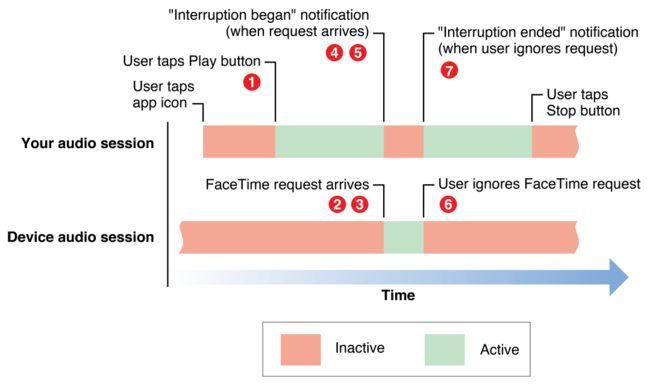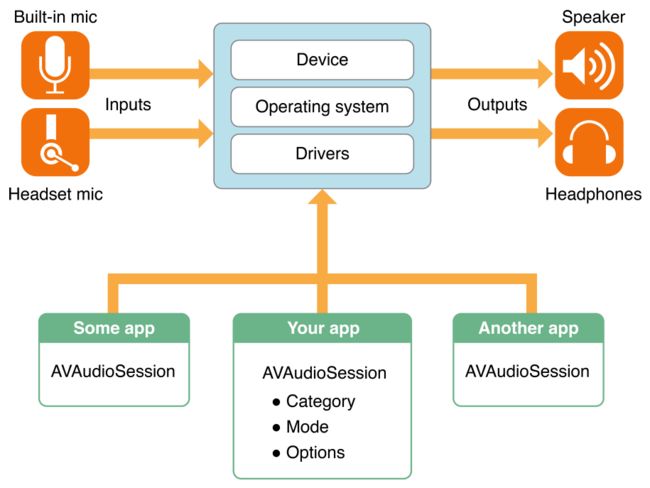iOS音频开发之Audio Session
系统通过Audio Session来管理App,App之间的和设备级别的音频行为。通过设置AVAudioSession的category和mode,可以告知系统如何在你的App中使用音频;可以监听音频中断(例如来电话)和音频路由(例如插上耳机)改变的通知;可以使用设置音频的采样率,I/O缓存持续时间和音频频道数。
系统默认的AudioSession有以下默认行为:1.只支持音频播放,不支持录音 2.设置响铃静音开关为静音模式下不会播放声音 3.设备锁屏不会播放声音 4.当你的App音频播放时,其他在后台播放的音频不会播放声音。如果需要与系统默认不同的音频播放行为,需要设置AudioSession,可以通过它的category和mode属性来实现。
// Access the shared, singleton audio session instance
let session = AVAudioSession.sharedInstance()
do {
// Configure the audio session for movie playback
try session.setCategory(AVAudioSessionCategoryPlayback,
mode: AVAudioSessionModeMoviePlayback,
options: [])
} catch let error as NSError {
print("Failed to set the audio session category and mode: \(error.localizedDescription)")
}
multiroute category 不同与其它category,它可以同时支持多个外接设备,例如同时插入了耳机和HDMI,那么音频流会同时流向这两个音频接口,也可以控制,不同的音频流流向不同的设备。
只有如下的category支持AirPlay的镜像和非镜像版本,
-
AVAudioSessionCategorySoloAmbient -
AVAudioSessionCategoryAmbient -
AVAudioSessionCategoryPlayback
AVAudioSessionCategoryPlayAndRecord category 下 modes 只支持 AirPlay的镜像版本:
-
AVAudioSessionModeDefault -
AVAudioSessionModeVideoChat -
AVAudioSessionModeGameChat
对于不同App之间的AVAudioSession竞争,由系统来管理。默认情况下,当你的App在前台运行并播放音频时,系统会默认激活AVAudioSession,你也可以通过session.setActive(true)来显式激活音频会话,但是当你的App进入后台时,如果不需要再使用AVAudioSession,那么需要显式释放它,让系统可以回收音频资源,供其他App使用。
可以在applicationDidBecomeActive:中通过secondaryAudioShouldBeSilencedHint来检测,也可以通过订阅AVAudioSessionSilenceSecondaryAudioHintNotification通知来实现
func setupNotifications() {
NotificationCenter.default.addObserver(self,
selector: #selector(handleSecondaryAudio),
name: .AVAudioSessionSilenceSecondaryAudioHint,
object: AVAudioSession.sharedInstance())
}
func handleSecondaryAudio(notification: Notification) {
// Determine hint type
guard let userInfo = notification.userInfo,
let typeValue = userInfo[AVAudioSessionSilenceSecondaryAudioHintTypeKey] as? UInt,
let type = AVAudioSessionSilenceSecondaryAudioHintType(rawValue: typeValue) else {
return
}
if type == .begin {
// Other app audio started playing - mute secondary audio
} else {
// Other app audio stopped playing - restart secondary audio
}
}当来电话,或者闹铃响了,或者是日历提醒发生时,你App的音频会话会被系统中断,需要注册监听系统通知来处理该类事件。
Figure 3-1 An audio session is interrupted 
func registerForNotifications() {
NotificationCenter.default.addObserver(self,
selector: #selector(handleInterruption),
name: .AVAudioSessionInterruption,
object: AVAudioSession.sharedInstance())
}
func handleInterruption(_ notification: Notification) {
guard let info = notification.userInfo,
let typeValue = info[AVAudioSessionInterruptionTypeKey] as? UInt,
let type = AVAudioSessionInterruptionType(rawValue: typeValue) else {
return
}
if type == .began {
// Interruption began, take appropriate actions (save state, update user interface)
}
else if type == .ended {
guard let optionsValue =
userInfo[AVAudioSessionInterruptionOptionKey] as? UInt else {
return
}
let options = AVAudioSessionInterruptionOptions(rawValue: optionsValue)
if options.contains(.shouldResume) {
// Interruption Ended - playback should resume
}
}
}当系统的音频服务被重置的时候,如果你需要对这种情况作出处理,需要监听AVAudioSessionMediaServicesWereResetNotification通知来处理,需要是实现以下操作
-
处理孤立的音频对象(如播放器,录音机,转换器或音频队列)并创建新的音频对象
-
重置正在跟踪的所有内部音频状态,包括所有属性
AVAudioSession -
适当时,
AVAudioSession使用该setActive:error:方法重新激活实例
另外当音频的路由变化时,也需要做相应的处理
Figure 4-1 Handling audio hardware route changes
func setupNotifications() {
NotificationCenter.default.addObserver(self,
selector: #selector(handleRouteChange),
name: .AVAudioSessionRouteChange,
object: AVAudioSession.sharedInstance())
}
func handleRouteChange(notification: NSNotification) {
guard let userInfo = notification.userInfo,
let reasonValue = userInfo[AVAudioSessionRouteChangeReasonKey] as? UInt,
let reason = AVAudioSessionRouteChangeReason(rawValue:reasonValue) else {
return
}
switch reason {
case .newDeviceAvailable:
let session = AVAudioSession.sharedInstance()
for output in session.currentRoute.outputs where output.portType == AVAudioSessionPortHeadphones {
headphonesConnected = true
}
case .oldDeviceUnavailable:
if let previousRoute =
userInfo[AVAudioSessionRouteChangePreviousRouteKey] as? AVAudioSessionRouteDescription {
for output in previousRoute.outputs where output.portType == AVAudioSessionPortHeadphones {
headphonesConnected = false
}
}
default: ()
}
}还可以设置硬件相关的属性:采样率,输入输出缓存等。
let session = AVAudioSession.sharedInstance()
// Configure category and mode
do {
try session.setCategory(AVAudioSessionCategoryRecord, mode: AVAudioSessionModeDefault)
} catch let error as NSError {
print("Unable to set category: \(error.localizedDescription)")
}
// Set preferred sample rate
do {
try session.setPreferredSampleRate(44_100)
} catch let error as NSError {
print("Unable to set preferred sample rate: \(error.localizedDescription)")
}
// Set preferred I/O buffer duration
do {
try session.setPreferredIOBufferDuration(0.005)
} catch let error as NSError {
print("Unable to set preferred I/O buffer duration: \(error.localizedDescription)")
}
// Activate the audio session
do {
try session.setActive(true)
} catch let error as NSError {
print("Unable to activate session. \(error.localizedDescription)")
}
// Query the audio session's ioBufferDuration and sampleRate properties
// to determine if the preferred values were set
print("Audio Session ioBufferDuration: \(session.ioBufferDuration), sampleRate: \(session.sampleRate)")设置 麦克风
// Preferred Mic = Front, Preferred Polar Pattern = Cardioid
let preferredMicOrientation = AVAudioSessionOrientationFront
let preferredPolarPattern = AVAudioSessionPolarPatternCardioid
// Retrieve your configured and activated audio session
let session = AVAudioSession.sharedInstance()
// Get available inputs
guard let inputs = session.availableInputs else { return }
// Find built-in mic
guard let builtInMic = inputs.first(where: {
$0.portType == AVAudioSessionPortBuiltInMic
}) else { return }
// Find the data source at the specified orientation
guard let dataSource = builtInMic.dataSources?.first (where: {
$0.orientation == preferredMicOrientation
}) else { return }
// Set data source's polar pattern
do {
try dataSource.setPreferredPolarPattern(preferredPolarPattern)
} catch let error as NSError {
print("Unable to preferred polar pattern: \(error.localizedDescription)")
}
// Set the data source as the input's preferred data source
do {
try builtInMic.setPreferredDataSource(dataSource)
} catch let error as NSError {
print("Unable to preferred dataSource: \(error.localizedDescription)")
}
// Set the built-in mic as the preferred input
// This call will be a no-op if already selected
do {
try session.setPreferredInput(builtInMic)
} catch let error as NSError {
print("Unable to preferred input: \(error.localizedDescription)")
}
// Print Active Configuration
session.currentRoute.inputs.forEach { portDesc in
print("Port: \(portDesc.portType)")
if let ds = portDesc.selectedDataSource {
print("Name: \(ds.dataSourceName)")
print("Polar Pattern: \(ds.selectedPolarPattern ?? "[none]")")
}
}请求录音授权:iOS10以后需要在plist文件里加NSMicrophoneUsageDescription。
AVAudioSession.sharedInstance().requestRecordPermission { granted in
if granted {
// User granted access. Present recording interface.
} else {
// Present message to user indicating that recording
// can't be performed until they change their preference
// under Settings -> Privacy -> Microphone
}
}

